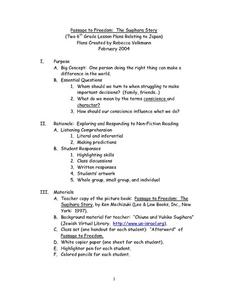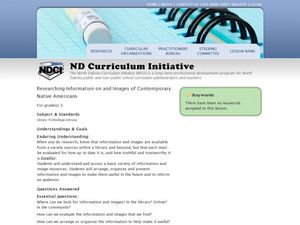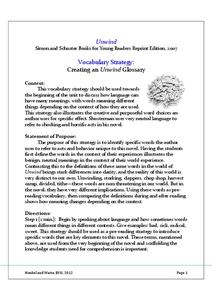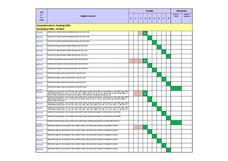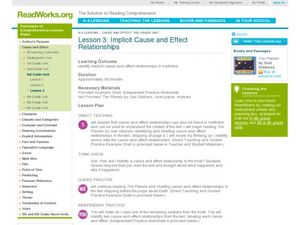Curated OER
Analyzing Textbook Formats
Students explore the characteristics of a non-fiction text. For this comprehension lesson, students are led on a guided tour of each text and identify the features of a non-fiction text. Students continue to practice locating features...
Curated OER
Just the Facts, Ma'am
Students use tables of content, chapter titles, and key words as a strategy for organizing non-fiction information. They write a paragraph with a partner using information from a graphic organizer.
Curated OER
Passage to Freedom: The Sugihara Story
Sixth graders engage in the reading of a non-fiction text in order to acquire character traits as displayed in the text.The story builds reading fluency through the teacher modeling correct style and speed.
Curated OER
Short and Sweet
Students explore how to summarize a text while reading. They discuss what it means to summarize. Students read a non-fiction text and practice summarizing the pages they read. They highlight the main ideas and important details within...
Curated OER
Reading Research!
Learners observe the pictures in non-fiction books that focus on animals in the winter. In addition, they also listed to some read aloud books about hibernation, migration, adaptation and dormancy. Students draw pictures and write notes...
Curated OER
Immigration to the United States
Middle schoolers discover the implications of immigration. For this immigration lesson, students read fiction based on immigration experiences as well as non-fiction on the topic. Middle schoolers write and share book reviews of the...
Curated OER
Evaluate Problem-Solving in the Context of Culture and Time-frame
Students examine literary elements in non-fiction literature. In this problem solving lesson, students read Rosa Parks, My Story and Beyond the Limits. Students make oral presentations based on the causes and effects, conflicts, and...
Pennsylvania Department of Education
Stories? Information? What's the Difference?
Students listen to a power point presentation to distinguish between fiction and nonfiction text. In this what's the difference lesson plan, students identify fact from opinion within a text. Students listen critically and respond to text.
Curated OER
Everybody Needs a Rock
Second graders examine science non-fiction books in the 500 section of the media center. They listen to Byrd Baylor's, Everybody Needs a Rock, and write a sentence that tells why everyone does need a rock. They illustrate the sentence.
Curated OER
Essential Meaning in Text Using Non-fiction Information Source
Students practice the skill of summarizing in writing the content of a passage or text and point out the main points in the story. They revise their skills on note-taking that they took the semester before and fine tune them more...
Curated OER
Rachel's Life is in a Hole
Explore how lack of access to water impacts peoples' lives in poor countries. Through text reading and discussion, middle schoolers are presented with the story of a young girl who lives and functions with limited water resources. They...
Curated OER
Butterfly, Butterfly: Teaching Vocabulary
Kindergarteners practice new words through listening to and reading the science book Butterfly by Jenny Feely. The teacher will first choose words that are essential for understanding the text. Then, using pictures in the text,...
Curated OER
Researching information on and Images of Contemporary Native Americans
Research information and find pictures of Contemporary Native Americans in order to help 3rd graders understand what images are available from a variety of resources. They will present their research and pictures to the class. In turn,...
National Center for Case Study Teaching in Science
A Strange Fish Indeed
Communication is one of the most important aspects of science. In a two-day activity, your high school or college-level biologists will read excerpts from a fictional diary of Marjorie Courtenay-Latimer, the woman who discovered the...
Penguin Books
An Educator’s Guide to Chraisma by Jeanne Ryan
Often, science fiction makes a lot of connections to real life. An educator's guide for the novel Charisma by Jeanne Ryan, has readers discuss many of the real-life issues that come in the text. A brief summary helps garner interest...
Curated OER
Unwind: Vocabulary Strategy, Creating an Unwind Glossary
Prior to reading Unwind, Neal Shusterman's 2007 young adult science fiction novel, class members research the common definition of words drawn from the novel that will come to have a very different meaning to them as they are...
Scholastic
Dear Miss Breed
This compelling plan based on the letters in the book Dear Miss Breed engages readers in learning what it was like for Japanese Americans following the attacks at Pearl Harbor. After reading the letters, young scholars will...
Benjamin Franklin Tercentenary
The Autobiography of Benjamin Franklin
Need a model for character education? Benjamin Franklin presents himself as in a constant state of striving to become the man he hoped to be, making his autobiography is far more accessible to learners than those of people who consider...
Curated OER
Summarizing Key Information
Students summarize information. In this language arts lesson, students summarize information from a fictional text. Students read a folktale and summarize the story.
Curated OER
Fact or Fantasy Writing
First graders see that some written text is for pleasure and enjoyment while some is for relaying information. They get to experience both types during the lesson. They brainstorm ideas for a story about a new kid in school to write about.
Curated OER
Implicit Cause and Effect Relationships
Cause and effect relationships can be found in both fiction and non-fiction texts. As they read the book, The Planets by Gail Gibbons, learners keep an eye out for cause and effect relationships. They chart all of the causes and effects...
Curated OER
Distinguishing Facts from Opinions
Third graders use a scavenger hunt worksheet to look through classroom books and resources and identify facts and opinions. In this fact and opinion lesson plan, 3rd graders look through non fiction and fiction books.
Curated OER
Super Summarizers
Pupils practice summarizing passages which they read silently in order to remember what they read. They follow steps for summarizing by highlighting the important details, removing the less important ones, and retelling they highlights...
Curated OER
The Bear Facts About Summarization
Students practice summarizing techniques in this lesson. They listen as the teacher reads from a non-fiction article, and the class creates a story map to highlight the most important facts from the article. They use the map to write a...
Other popular searches
- Non Fiction
- Non Fiction Text Features
- Non Fiction
- Non Fiction Writing
- Non Fiction Reading Passages
- Non Fiction Text
- Non Fiction Reading
- Non Fiction Reading
- Non Fiction Text Features
- Creative Non Fiction
- Elements of Non Fiction
- Non Fiction Graphic Organizer


